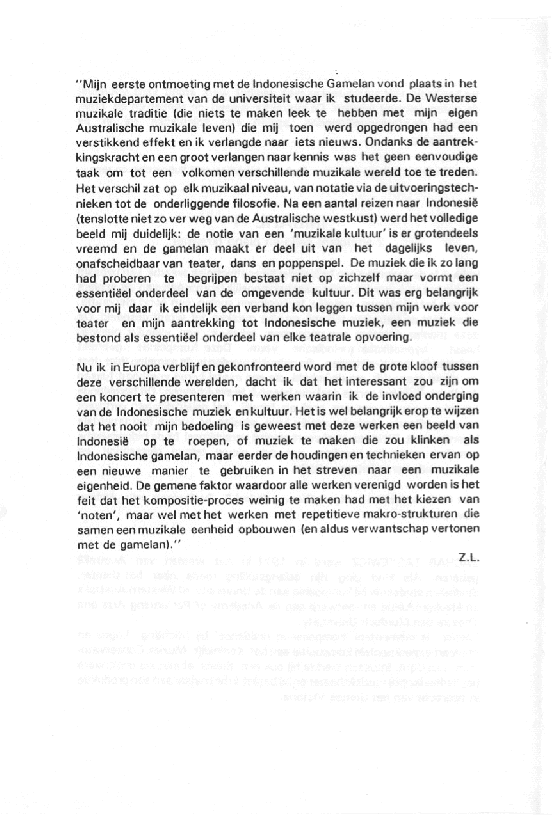
IMBAHL
a concert of music by Zachàr Laskewicz
|
The Logos Foundation Tuesday 6 July 1993 IMBAHL a concert of works by ZACHAR LASKEWICZ
Programme INDIA SONG - Overture and piano blues 2 flutes, alto flute, voice, cello, synthesizer and piano Written for a performance of the similarly entitled play by Marguerite Duras, this composition gradually evolves into a piano-blues, a piece which symbolically stands for one of the characters in the play. The work was composed to bridge the gap between the audience and the world of India Song, formed by half forgotten and misformed memories of woman long dead. The chordal structure which is used in the piano-blues melody is stretched a number of times and is taken up in the structure of the piece to completely develop. Gamelan techniques are clear in the final piano-blues, where a tempo change introduces a more complex melody in the right hand, whereas the left hand stays repeaking the same pattern. Bert Jacobs & johan Dierckz, flutes - Karin Defleyt, alto flute - Eve Francois, cello - Zachar Laskewicz, synthesizer - Andrew Sturt, piano - Machteld Willems, voice (tape).
The Power of Steam Machines 3 flutes and piano (world premiere) A piece using a repeating 11 bar ostinato played n the piano, and constantly forward developing flute melodies. The Power of Steam Machines developed into two other works, Powah and The Power of Steam Machines-2, but this is the first performance of the original work. The flutes were designed to represent the steam-machines in the work, propelled constantly forward by the locomotive nature of the piano part. Break During the break you will hear a recording of Transmigration II, a work for gamelan, voice and other western instruments. MOOD MOVEMENT & REFLECTION flute and tape A 'symmetrical' composition that gradually develops until a central point is reached, from where it 'reflects' back to the beginning again. The structural element of the composition was entirely planned before notes were chosen, and interaction between the live instrumentalist and the tape, and also the stereo positioning of the prerecorded flutes, play an important role in the development.
IMBAHL-1 2 violas, cello and piano (world premiere) Imbahl is the name for an Indonesian playing technique where a certain point in the composition is reached where it is possible for one of the players to begin playing an entirely new melody, a sort of an elaboration, but where the elaboration is played on every off beat creating an unusual texture and an entirely new, almost hypnotic, melodic form. This composition uses repeating 'gong' patterns that are used in the gamelan (played by the piano) to structure the imbahl which occurs a number of times between the violas in the first half of this piece. This repeating gong pattern begins very fast, and as it gradually slows and goes through a number of different rhythmic levels, other instrumental layers fade in and out as the slower tempo allows. This is a factor common with Indonesian gamelan, where the reaching of a new tempo brings about sudden and surprising changes.
"I first enountered Indonesian gamelan in the music department of the university in which I studied. Feeling stifled by the conservative Western musical traditions that were being forced upon me at the time, traditions that seemed to have nothing to do with my own musical life in Australia, I was longing to try something new. Despite the attraction and a great desire to learn, it was no easy task to enter a completely different musical world, different on almost every musical level - from notation through performance methods to the underlying musical philosophy. After travelling a number of times to Indonesia (which lies fairly close to the coast of Western Australia) had the possibility of seeing the full picture: the notion of a 'musical culture' is largely alien, and the gamelan forms a part of eveyday Indonesian life, inseparable from theatre, dance, and puppetry. The music which I had grappled for so long to undertsand did not actually exist on its own but as an essential part of the culture that surrounded it. This was ver important for me as I could finally find a connection between my theatre work and the attraction to Indonesian music, a music that existed as an essential part of all performance. Living in Europe, and feeling a vast gap between the different worlds that I have experienced, I thought it would be interesting to present a concert of my pieces that had been influenced by Indonesian music and culture. It is important to note that the intention of these pieces was never to 'evoke' a sense of Indonesia, or try to make music that sounded like Indonesian gamelan, but rather to use these attitudes and techniques in a new way to help me find a compositional voice. The common factor that unites all the pieces is the fact the composition process had little to do with choosing 'notes', but in working with larger scale repeating strcutres that work together to create a musical unity, common of course also with the gamelan."
|




